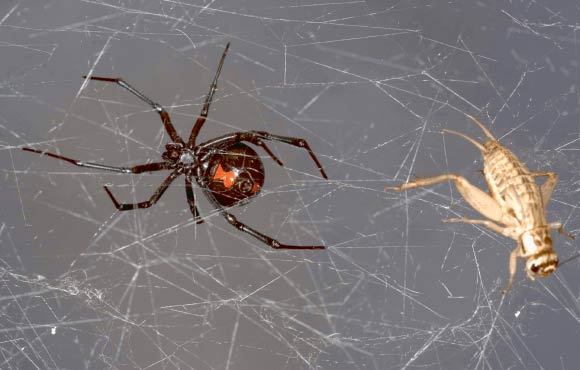Using black widow spiders, a team of scientists has successfully extracted, amplified, and sequenced mitochondrial DNA from spider webs that identified both spider and prey to species.

Southern black widow spider (Latrodectus mactans) with its prey house cricket (Acheta domesticus) trapped in spider web. Image credit: Scott Camazine, doi: 10.1371/journal.pone.0142503.g001.
The team, led by Dr Charles Xu of the University of Notre Dame, used three black widow spiders (Latrodectus spp.) fed with house crickets (Acheta domesticus) to noninvasively extract, amplify, and sequence mitochondrial DNA from spider web samples.
“Spider web is an ideal source of noninvasive genetic material for spiders because web can be found and collected without the need to directly observe or capture spiders themselves,” Dr Xu and co-authors wrote in a paper in the journal PLoS ONE.
“Furthermore, unlike most spiders, which are small, mobile, and elusive, webs are relatively large, stationary, and often clearly visible.”
The detectability of spider DNA did not differ between assays, and spider and prey DNA remained detectable at least 88 days after living organisms were no longer present on the web.
“These results may encourage further studies that could lead to practical applications in conservation research, pest management, biogeography studies, and biodiversity assessments,” the researchers said.
However, further testing of field-collected spider webs from more species and habitats is needed to evaluate the generality of these findings.
“Sticky spider webs are natural DNA samplers, trapping nearby insects and other things blowing in the wind,” Dr Xu explained. “We see potential for broad environmental monitoring because spiders build webs in so many places.”
“We provide a proof-of-concept that noninvasive DNA of a spider and its prey can be extracted from spider web and be used for species identification,” the scientists said.
“Spider web DNA appears to be a promising tool with wide applications in biomonitoring, biogeography and biodiversity assessments of spiders and their prey, especially if combined with the power of massively parallel sequencing.”
This study represents the first demonstration of spider web as a source of noninvasive genetic material.
_____
Xu C.C.Y. et al. 2015. Spider Web DNA: A New Spin on Noninvasive Genetics of Predator and Prey. PLoS ONE 10 (11): e0142503; doi: 10.1371/journal.pone.0142503







